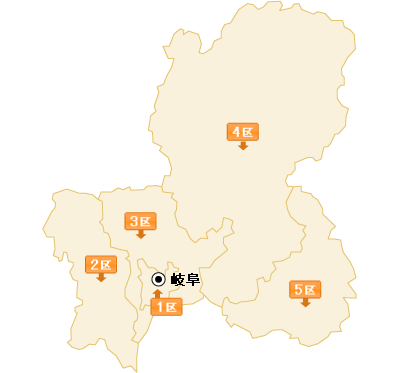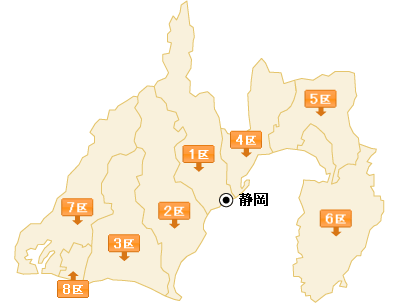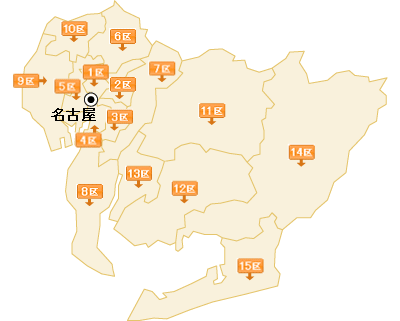This is the seventh installment in my general election guide. For an explanation of my purpose in making this guide, see here. For previous installments, see here, here, here, here, here, and here.
The Tokai block, comprised of Gifu, Shizuoka, Aichi, and Mie prefectures, is Japan's industrial heartland. Aichi, the fourth most populous prefecture, is home to several major corporations, most notably Toyota, and the population of the Nagoya metropolitan area, along with the Tokyo metropolitan area, continues to grow while that of other areas shrinks.
The Tokai block elects fifty-four Diet members, thirty-three members from single-member districts and twenty-one through proportional representation.
The LDP and the DPJ have been fairly evenly matched in the region: in PR voting in 2005 the LDP and Komeito took twelve seats, with the DPJ taking eight, and the JCP taking one. In 2003, the LDP and Komeito took eleven, while the DPJ took nine and the JCP one. Meanwhile, in SMDs the LDP and Komeito won twenty-three in 2005, with the DPJ's winning the remaining ten. In 2003, however, the split was eighteen to fifteen in the governing coalition's favor, suggesting that the DPJ should have little difficulty picking up ground in the Tokai block.
Gifu
Of the block's four prefectures, the LDP is strongest in Gifu. Since the first general election under the new electoral system in 1996, the DPJ has never won an SMD in the prefecture.
 LDP incumbents Noda Seiko (first district), in the Aso cabinet holding the portfolios for food safety, science and technology, consumer affairs and space policy, Tanahashi Yasufumi (second district), Kaneko Kazuyoshi (fourth district), Aso's minister for land and transport, and Furuya Keiji (fifth district), a postal rebel in 2005 subsequently readmitted to the LDP should win reelection comfortably. The DPJ candidates facing these incumbents are newcomers to politics, and the DPJ has performed poorly in these districts in the past.
LDP incumbents Noda Seiko (first district), in the Aso cabinet holding the portfolios for food safety, science and technology, consumer affairs and space policy, Tanahashi Yasufumi (second district), Kaneko Kazuyoshi (fourth district), Aso's minister for land and transport, and Furuya Keiji (fifth district), a postal rebel in 2005 subsequently readmitted to the LDP should win reelection comfortably. The DPJ candidates facing these incumbents are newcomers to politics, and the DPJ has performed poorly in these districts in the past.In the third district, however, the DPJ stands a chance of picking up an SMD in Gifu for the first time. LDP incumbent Muto Yoji inherited in the seat from his father in 2005; he is a fourth-generation politician, and is a member of Aso Taro's faction. In 2005, however, his rival, DPJ candidate Sonoda Yasuhiro, lost by 17,000 votes and won a PR seat for the second time, as in 2003 he lost to Muto's father by only 5,000 votes. Sonoda should be able to win the district this year.
Shizuoka
The LDP and Komeito won six of eight seats in Shizuoka in 2005, and five of eight in 2003.
DPJ incumbents Hosono Goji (fifth district) and Watanabe Shu (sixth district) should win reelection comfortably. The DPJ should win in the first district, where the DPJ's Makino Seishu, who won the district in 2003, will be fighting to retake it from Kamikawa Yoko, the LDP incumbent he defeated in 2003 (and lost to by 500 votes in 2000). While the JCP will be fielding a candidate in the district, Makino won in 2003 despite both the JCP and the SDPJ's fielding candidates. The DPJ's position in the fourth district is also strong: for the third straight
 election the LDP's Mochizuki Yoshio will face DPJ challenger Tamura Kenji. Tamura received nearly 46% of the vote in 2005, good for a PR seat and up from nearly 40% in 2003, when he had to share the field with a JCP candidate who received 7% of the vote. The DPJ should win the eighth district as well: for the fourth time, LDP incumbent Shionoya Ryu and DPJ challenger Suzuki Yasutomo will be battling, with a JCP candidate also in the race. Shionoya first won the seat in a by-election in the late 1990s, and again in 2003 and 2005. Suzuki won in 2000 and lost by 3,000 votes in 2003, earning him a PR seat. Suzuki should win this round. The DPJ also stands a good chance of winning in the second district, where for the fourth straight election DPJ candidate Tsugawa Shogo will try to win the seat from the LDP incumbent, Harada Yoshitsugu. (Harada inherited the seat from his father in 2003 — Tsugawa won a PR seat running against Harada pere in 2000, and belatedly won a PR seat in 2003 when another Diet member was forced to resign.)
election the LDP's Mochizuki Yoshio will face DPJ challenger Tamura Kenji. Tamura received nearly 46% of the vote in 2005, good for a PR seat and up from nearly 40% in 2003, when he had to share the field with a JCP candidate who received 7% of the vote. The DPJ should win the eighth district as well: for the fourth time, LDP incumbent Shionoya Ryu and DPJ challenger Suzuki Yasutomo will be battling, with a JCP candidate also in the race. Shionoya first won the seat in a by-election in the late 1990s, and again in 2003 and 2005. Suzuki won in 2000 and lost by 3,000 votes in 2003, earning him a PR seat. Suzuki should win this round. The DPJ also stands a good chance of winning in the second district, where for the fourth straight election DPJ candidate Tsugawa Shogo will try to win the seat from the LDP incumbent, Harada Yoshitsugu. (Harada inherited the seat from his father in 2003 — Tsugawa won a PR seat running against Harada pere in 2000, and belatedly won a PR seat in 2003 when another Diet member was forced to resign.)Harder to predict is the seventh district, where Katayama Satsuki, a former finance ministry official recruited as an LDP candidate in 2005, is vulnerable to the same trend that threatens other Koizumi children. The battle in the seventh district will be similar to 2005, when Katayama defeated postal rebel Kiuchi Minoru by 700 votes, with the DPJ candidate finishing a distant third. Kiuchi will be running again — and will be repeating 2005's campaign against the Koizumi reforms. Appropriately, Koizumi Junichiro has already visited the district in support of Katayama. The DPJ is running Saiki Takeshi, a former NHK announcer. The DPJ won the district in 2000, so it is possible for the DPJ to win here. The question is what matters more: policy or party identification. If voters in the seventh care more about party identity, Saiki may have a chance; if they vote more on the basis of policy, Kiuchi may be returning to the Diet. I suspect Kiuchi will win.
The LDP's most secure seat is the third district, where Yanagisawa Hakuo, perhaps now best known as the Abe cabinet minister who referred to women as "machines for giving birth," faces DPJ newcomer Koyama Nobuhiro, a former Norin Chukin employee. Like most LDP incumbents Yanagisawa is nervous — Yomiuri reports that for the first time he requested an endorsement from Komeito, and actually launched a website (!) — due to the weakening of the LDP's organizational vote. But Yanagisawa should hold on to his seat comfortably.
The result could be the DPJ's winning six of eight seats in Shizuoka.
Aichi
Aichi is, not surprisingly, the largest prefecture in the block, electing fifteen representatives. The DPJ has done well in Aichi in the past — in 2003 the party won ten seats to the LDP's three (Komeito won two). However, in 2005 the LDP took nine seats, with the DPJ's winning the remaining six.
DPJ incumbents Furukawa Motohisa (second district), Kondo Shoichi (third district), Maki Yoshio (fourth district), Furimoto Shinichiro (eleventh district), and Suzuki Katsumasa (fourteenth district) should win reelection easily. In the first district, Kawamura Takashi, who had represented the district since 1996, resigned when he was elected the mayor of Nagoya earlier this year. In his place will be running Sato Yuko, an Aichi prefectural assemblywoman. Given Kawamura's longtime success in the district, indeed given the DPJ's dominance in Nagoyama (it won four of five districts in the city in 2005, and a PR seat in the fifth and now obviously controls the mayoralty), Sato should win comfortably.
 Additionally, the DPJ should win the fifth district easily, where Akamatsu Hirotaka, currently the DPJ's chief election strategist, won in 1996, 2000, and 2003 before losing by 10,000 votes in 2005 to LDP candidate Kimura Takahide, who is purportedly retiring due to his having voted for postal privatization in 2005 despite personally opposing it. In his place the LDP is running businessman Teranishi Mutsumi. The DPJ should also win in the other districts it won in 2003 but lost in 2005. In the sixth district, the DPJ won in 2000 and 2003 (and a PR seat in 2005) with candidate Maeda Yukichi, who announced last year that he would not run in this election. Replacing Maeda as the party's standard bearer is Ishida Yoshihiro, who served two terms as mayor of Inuyama city (one of the cities in the sixth) before losing by 7,000 votes in Aichi's 2007 gubernatorial election. Ishida will likely defeat LDP incumbent Niwa Hideki. Similarly, in the seventh district, the DPJ won the district in 2000 and 2003 before LDP incumbent Suzuki Junji won the seat in 2005. Unlike past elections, however, neither the SDPJ nor the JCP will be fielding candidates this time — as the DPJ won in the past despite the divided field (the JCP and SDPJ combined received 36,000 votes in 2003), DPJ candidate Yamao Shiori should win comfortably this time. The DPJ should also win easily in the eighth district, where Banno Yutaka won in 2003 (and lost but won PR seats in 2000 and 2005) — Banno lost by only 7,000 votes to LDP incumbent Ito Tadahiko in 2005. Similarly, in the ninth district in 2003 and 2005 Okamato Mitsunori lost to former Prime Minister Kaifu Toshiki but won PR seats both times, losing by 12,000 votes in 2003 and 20,000 votes in 2005. This year Kaifu, who has won sixteen times, may finally be defeated.
Additionally, the DPJ should win the fifth district easily, where Akamatsu Hirotaka, currently the DPJ's chief election strategist, won in 1996, 2000, and 2003 before losing by 10,000 votes in 2005 to LDP candidate Kimura Takahide, who is purportedly retiring due to his having voted for postal privatization in 2005 despite personally opposing it. In his place the LDP is running businessman Teranishi Mutsumi. The DPJ should also win in the other districts it won in 2003 but lost in 2005. In the sixth district, the DPJ won in 2000 and 2003 (and a PR seat in 2005) with candidate Maeda Yukichi, who announced last year that he would not run in this election. Replacing Maeda as the party's standard bearer is Ishida Yoshihiro, who served two terms as mayor of Inuyama city (one of the cities in the sixth) before losing by 7,000 votes in Aichi's 2007 gubernatorial election. Ishida will likely defeat LDP incumbent Niwa Hideki. Similarly, in the seventh district, the DPJ won the district in 2000 and 2003 before LDP incumbent Suzuki Junji won the seat in 2005. Unlike past elections, however, neither the SDPJ nor the JCP will be fielding candidates this time — as the DPJ won in the past despite the divided field (the JCP and SDPJ combined received 36,000 votes in 2003), DPJ candidate Yamao Shiori should win comfortably this time. The DPJ should also win easily in the eighth district, where Banno Yutaka won in 2003 (and lost but won PR seats in 2000 and 2005) — Banno lost by only 7,000 votes to LDP incumbent Ito Tadahiko in 2005. Similarly, in the ninth district in 2003 and 2005 Okamato Mitsunori lost to former Prime Minister Kaifu Toshiki but won PR seats both times, losing by 12,000 votes in 2003 and 20,000 votes in 2005. This year Kaifu, who has won sixteen times, may finally be defeated.The DPJ's position is a bit more uncertain in the tenth, twelfth, thirteenth, and fifteenth districts, where DPJ candidates lost in 2003 and did well enough to win PR seats — but were defeated by sizable enough margins in 2005 to not win PR seats. In the tenth, LDP incumbent Esaki Tetsuma won by fewer than 800 votes in 2003 when he was running as a Conservative Party candidate. He won by 36,000 votes in 2005 over his DPJ challenger this year, Sugimoto Kazumi. The JCP, which has received 20,000 votes in the past two elections, will not be fielding a candidate this time, which should help swing the seat to the DPJ. In the twelfth, DPJ candidate Nakane Yasuhiro will try for the fourth time to unseat LDP incumbent Sugiura Seiken. Nakane has come close in the past, and should receive enough support this time to win. In the thirteenth, former DPJ candidate Shima Satoshi lost by less than 5,000 votes and won a PR seat against the LDP's Omura Hideaki. Shima lost decisively in 2005, and this time the DPJ candidate will be former diplomat Onishi Kensuke. Again, the narrow margin in 2003 suggests that the DPJ could win the district this year. In the fifteenth district, the DPJ came within 16,000 votes of incumbent Yamamoto Akihiko, but Morimoto Kazuyoshi, the DPJ's candidate in 2005 (and this year), lost by nearly 50,000 votes. Yamamoto should win reelection.
The DPJ could win thirteen seats in Aichi, and has at least a decent chance of winning all fifteen seats.
Mie
Mie has five districts, which the LDP and DPJ divided three and two in 2003 and 2005.
DPJ incumbents Nakagawa Masaharu (second district) and Okada Katsuya (third district) should win comfortably this year.
LDP incumbent Mitsuya Norio (fifth district) may feel threatened to the point of announcing that he will not be running simultaneously as a PR candidate (to show his seriousness to his constituents) — but he is probably the LDP's safest incumbent in the district.
For the fifth straight election the first district will feature a showdown between LDP incumbent
 Kawasaki Jiro and DPJ challenger Nakai Hiroshi. Nakai won the seat as a New Frontier Party candidate in 1996, but has lost to Kawasaki in the three elections since, winning a PR seat each time. Nakai may be a beneficiary of the absence of a JCP candidate: in 2003, for example, the JCP candidate received 11,000 votes, roughly the same as Kawasaki's margin of victory.
Kawasaki Jiro and DPJ challenger Nakai Hiroshi. Nakai won the seat as a New Frontier Party candidate in 1996, but has lost to Kawasaki in the three elections since, winning a PR seat each time. Nakai may be a beneficiary of the absence of a JCP candidate: in 2003, for example, the JCP candidate received 11,000 votes, roughly the same as Kawasaki's margin of victory.In the fourth district, LDP incumbent Tamura Norihisa faces DPJ challenger Morimoto Tetsuo for the second time. Morimoto, a former Mie prefectural assemblyman, lost by only 13,000 votes to Tamura in 2005, winning a PR seat. Mainichi reports that Morimoto has focused his efforts on the areas of the district he performed poorly in in 2005, suggesting that he may be able to close the gap — he'll certainly have help from the national mood.
The DPJ should win four of five seats in Mie.
Proportional representation
Once again using the d'Hondt method simulator, Yomiuri's latest polling data, and turnout data from 2005, it is possible that the DPJ will win twelve seats, the LDP seven, and Komeito and the JCP one each.
Between SMDs and PR voting, the DPJ could win thirty-six of fifty-four seats in the block, leaving the LDP with sixteen seats, and Komeito and the JCP with one apiece.

No comments:
Post a Comment